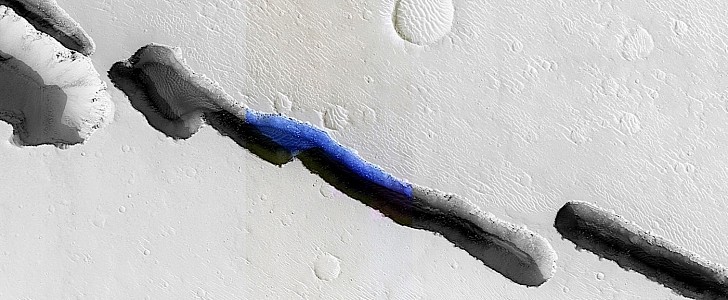I think it’s safe to say our knowledge of neighboring planet Mars is marginal at best. After looking at that red spot of light in the sky for centuries and exploring it from its orbit and surface for decades, the place still manages to surprise us.
Take the Cerberus Fossae region of the planet, for instance, located in the southeastern region of Elysium Planitia. We know about the place being filled with “a series of discontinuous fissures,” but we know little of how they formed, or why they appear not only discontinuous, but also offset.
We’ve featured this area of Mars before, and here it is again, a portion of it at least, shown in close detail by the HiRISE orbital camera. Snapped in infrared color all the way back in 2014, the image was only published this year by the University of Arizona, which together with NASA runs the instrument.
As far as our scientists are able to guess, these fissures formed as a result of volcanic and tectonic processes, and they probably don’t come as a single, long rift because of a preexisting subsurface fault.
Although it may not seem like it in this pic, complicated math led scientists to estimate the blue rift before our eyes is 260 meters (853 feet) deep and just as wide.
Another aspect scientists are able to find an answer to using these images is why the depths of the rifts in this region appear blue to the HiRISE camera, when pretty much every other place up there looks orange-grayish.
According to them, the answer is that’s the color volcanic and mafic sand filled with unoxidized iron gets when looked at this way, as opposed to the surface-spread oxidized iron found in sand on the surface.
We’ve featured this area of Mars before, and here it is again, a portion of it at least, shown in close detail by the HiRISE orbital camera. Snapped in infrared color all the way back in 2014, the image was only published this year by the University of Arizona, which together with NASA runs the instrument.
As far as our scientists are able to guess, these fissures formed as a result of volcanic and tectonic processes, and they probably don’t come as a single, long rift because of a preexisting subsurface fault.
Although it may not seem like it in this pic, complicated math led scientists to estimate the blue rift before our eyes is 260 meters (853 feet) deep and just as wide.
Another aspect scientists are able to find an answer to using these images is why the depths of the rifts in this region appear blue to the HiRISE camera, when pretty much every other place up there looks orange-grayish.
According to them, the answer is that’s the color volcanic and mafic sand filled with unoxidized iron gets when looked at this way, as opposed to the surface-spread oxidized iron found in sand on the surface.








